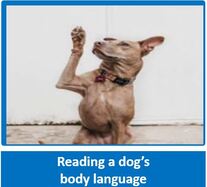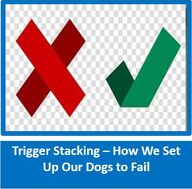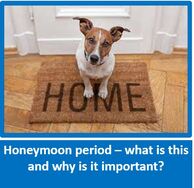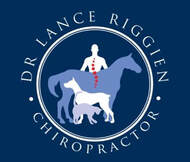
Dr Lance is based at the Durbanville Natural Health Centre where he treats small animals and human patients. He also travels extensively over South-Africa to treat equine patients.
His services include a thorough assessment & treatments for various conditions, such as Stiffness - Chronic musculoskeletal problems - Lameness - Spine Injuries - Joint pain - Gait abnormalities.
The benefits of chiropractic and shockwave therapy for animals include - General wellness - Enhanced performance - Improved quality of life. www.animal-chiropractor.co.za : www.shockwavetherapy.co.za
His services include a thorough assessment & treatments for various conditions, such as Stiffness - Chronic musculoskeletal problems - Lameness - Spine Injuries - Joint pain - Gait abnormalities.
The benefits of chiropractic and shockwave therapy for animals include - General wellness - Enhanced performance - Improved quality of life. www.animal-chiropractor.co.za : www.shockwavetherapy.co.za
Introducing a New Dog to Existing Dog
By Scotty Valadao – Canine Behaviourist - www.friendsofthedog.co.za
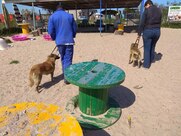 Dogs walking same direction with obstacles between them.
Dogs walking same direction with obstacles between them.
The old fashioned manner of introducing dogs, was that you brought the new dog home, let both dogs off-lead, and had the vet on standby! Thankfully, we have learnt a lot more since those days, and taking your time and doing things in the correct manner, is a far better way to go and more likely to have a successful outcome.
Introducing the dogs prior to adopting
Below is aimed at dogs that are not always reactive/aggressive to other dogs.
Preparation
- Always do initial introductions on neutral territory, with no other dogs around, and make sure no toys, food lying around that could cause possible problems. Nothing in the area belongs to either dog, so resource guarding will not be a concern.
- If it is possible, arrange for each dog to have access to sleep on a small blanket for a day or two. Once the dogs scent is on the blanket, then swap the blanket around - this will give both dogs the opportunity of scenting one another before the meeting.
- Cut up small, high value treats that can be used for both dogs to reward good behaviour - if their is any resource guarding of food, you have to bear this in mind.
- It is always a good idea to have both dogs go for a walk (separately) before the meeting is attempted. this will help to lower stress levels.
- Ensure that all equipment fits properly and cannot come off. I suggest using two points of contact to help make the dogs feel more secure. This would be a collar and harness, with either a double lead that can be clipped to harness and lead separately, or you can even use two leads.
- Dogs to walk at your side - the second a dog goes in front of you, you have lost control and the likelihood of lunging, straining or reactive behaviour towards the other dog is increased. If at all possible, practice this skill before the Meet and Greet.
- What is vitally important is that the people handling each dog hold the lead firmly, but not with clenched hands - tension travels down the lead - additionally, your own body language needs to be relaxed - even hum a song quietly to help keep yourself relaxed.
- Reward dogs with praise and a treat for any good behaviour such as walking past other dog without reacting, glancing at the other dog. The more you praise and treat the behaviour you do want, the more the dog is likely to respond in a positive fashion.
- Especially if dogs are stressed, you can have regular breaks before starting again. Lead dogs away from each other, offer water, and even take them for a slow scenting short walk in the area - this will help to lower stress levels.
- When starting again go back a step so that the dogs start with what they have already experienced.
How To - Neutral Location
(Handlers to let each other know if there dog is not coping or needs a break). This work to be done slowly with both dogs coping. Ideally do several days in a row - this will depend on how the dogs get on.
- Firstly you want to establish the critical distance that the dogs can tolerate. This is the distance between the dogs where there is not reaction from either dog and stick to that distance initially. You can even put some obstacles between the dogs such as two chairs with a blanket over them, if you don't have anything more suitable.
- Just stand quietly with each dog respecting the critical distance, and only start the work when both dogs are quiet - taking this little bit of extra time will help to set you up for success.
- Keeping the critical distance in place, dogs walk in the same direction (this is so that eyeballing cannot occur). Keep praising quietly and treating for good behaviour. Keep this up until the dogs are totally relaxed.
- Now, a step at a time, you will bring the dogs one step closer to one another. At each stage, ensure the dogs are coping and relaxed before bringing them closer together. We would suggest that, at this stage, you keep about a minimum of 3 metres apart. .
- If either of the dogs eliminates, lead that dog away from the area, and allow the other dog to come over an smell it.
- Once this stage has been successfully completed, you will start at the beginning again with the same critical distance you had initially, and repeat the process above, but this time facing one another. As the dogs face one another, you may find that initially the stress levels may increase with a degree of reactive behaviour been shown - just increase the critical distance and go slowly. Do not make a fuss if this occurs, be quiet calm, and relaxed.
Introductions at home
Remove anything that could cause resource guarding such as toys, food bowls, beds etc.
Have a friend or family member bring the new dog, and rather than meeting at home, arrange to go for a walk in neutral territory. As the dogs have already met one another, the stress levels will be lower.
Do not let them go up to one another immediately, rather keep to walking them parallel, on occasion going closer to one another. When you feel both dogs are relaxed, you can allow them to have a split second greeting. If dogs are too long together at this stage stress can increase - rather a few short, few seconds meeting until totally relaxed.
If one of the dogs eliminates (and it probably will), ask the person who is walking this particular dog to walk away a bit and take the other dog over to sniff and investigate. As the dogs settle down and become more relaxed, start walking a bit closer to one another and see what reaction you get. Don’t go too quickly, work at a pace the dogs are comfortable with and every so often walk them away from one another.
If everything is going well, you can now take the dog’s home, but before you go into the driveway, allow the dogs to meet casually on the opposite side of the road and do some sniffing and smelling to relax them and then walk them together into the property. Allow them to sniff and smell in the garden area and then lead them into the home.
Initially, I would suggest keeping both dogs on lead and observe their interactions. Be aware that if problems do occur, it is normally near food bowls, toys, bones, one dog on furniture and the other on the floor as well as at doorways, so make sure all the above has been put out of the way and avoid any problems at doorways and furniture.
You now have various options as to how you proceed and this will depend on the interaction to date:-
- You can either keep the above in place for a few days, keeping the dogs separate while outside and walking them together daily and allowing them to interact in the house - this will all depend on how well the dogs get on.
- If one dog seems a bit unsure, then rather keep this dog on lead for a while longer in the home and allow the other dog off lead.
- Another alternative is to desensitize the dog that appears to be a bit reactive to a muzzle and keep the muzzle on during the interactions. Not only will this prevent any damage being done, it will lower your own stress levels which will also impact on the dog.
Depending on how the above goes will determine whether or not you allow the dogs to interact further. If you do allow them off lead, keep control of the situation by not letting them get overly excited and keep on calling them back and asking for a sit and settle for short periods of time.
Although this method does take longer than just letting the dogs off lead to ‘get on with it’ as the saying goes, you can be assured that you are keeping the possibility of reactive behaviour down to an absolute minimum and are controlling the situation.
- If, at any stage you are in doubt, please call in a professional to assist you and until you are absolutely certain that the dogs have bonded, please supervise all interactions.


